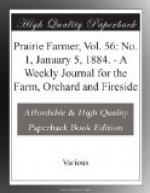ANSWER.—We don’t know. Will someone familiar with cowboys and their manner of living report. However, all things considered, the ration is not a bad one, for the reason that raw beef digests in half the time of beef well cooked, and the large, sweet pepper of the Southwest deprived of its seeds is not near as hot in the mouth as it is commonly represented.
R. ROOT, CLARKSVILLE, IOWA. 1. Does the basket willow have to be cultivated like a field crop? 2. Is there more than one kind, and if so which is best? 3. What kind of soil is best adapted to its cultivation?
ANSWER.—1. In some respects, yes; the land having to be given over to them exclusively. In France the cuttings are planted from twelve to fifteen inches apart in order to obtain long and slender shoots. 2. There are half a dozen cultivated in Europe, the best two being the Salix rubra or red Osier, and the Salix vitellina or yellow Osier. But a hardier variety, Salix viminalis, is commonly preferred in this country where the cultivation, though often undertaken, has never been very successful, from the fact that American labor can not compete with the labor of women and children in Europe. 3. In cool climates having a moist atmosphere the Osier willow is successfully grown where ordinary crops thrive, but in warmer and drier sections low and moist land must be chosen. Indeed the whole tribe of willows love cool, moist situations, and the richer the soil the stronger and quicker the growth. We should be glad to hear from correspondents who cultivate, or who live where the Osier is grown and prepared for market, the details of the whole industry.
B.F.J.
WAYSIDE NOTES.
BY A MAN OF THE PRAIRIE.
I don’t know that I really ought to take any credit to myself for it, but I hope I have done something toward increasing the number of farmer correspondents for the hale old PRAIRIE FARMER. I can’t help noticing, as I do with pleasure, that the number is increasing. Furthermore, the correspondents all write well, I mean, simply; they seem to have something to say, and say it in a manner that can be readily understood. Their writings are instructive, too. Well, I hope this writing fever, like most others, will prove highly contagious, and have a run through the entire PRAIRIE FARMER family. I know from experience the malady is not a dangerous one. At least it don’t do the writers any harm; if the readers can stand what I say, I am satisfied. The editor may boil down our communications, or chop them up and serve them in any style he chooses, so that he presents all the good we mean to say, and we will be satisfied. Will we not, fellow-contributors?
* * * * *




